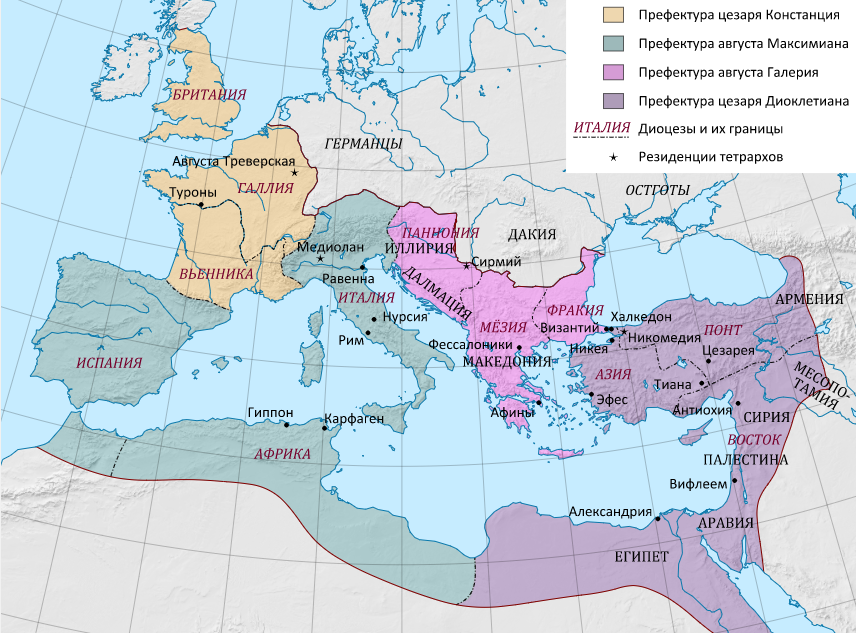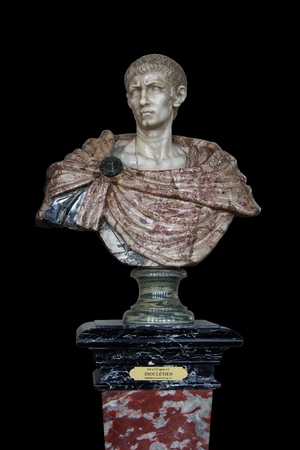Dominat
The Dominat (Latin: dominatus, "domination") was a form of government in Ancient Rome that succeeded the Principate and was established by Emperor Diocletian (284-305 AD). The period of the Tetrarchy is also included within the Dominat.
Tetrarchy (Greek: tetrarchia, "rule of four") refers to a political regime in which supreme power is divided among four individuals (tetrarchs, rulers of four). Typically, the term tetrarchy is used to describe the system of governance in the Roman Empire introduced by Emperor Diocletian in 293 AD and lasting until 313 AD. Its introduction resolved the Crisis of the Third Century in the Roman Empire.
The term "Dominat" usually refers to the period of Roman history from the 3rd to the 5th century AD. This period is also known as "Late Antiquity" or the "Late Empire." The term "Dominat" derives from the customary address to the emperor at that time: Dominus et deus noster sic fieri iubet ("our lord and god commands it" in Latin). Domitian was the first to refer to himself this way.
 Map of the Roman Empire of the Dominant era
Map of the Roman Empire of the Dominant era
While such a claim by the emperor was met with hostility by the Romans at the end of the 1st century, by the end of the 3rd century, the term "dominus" was accepted more calmly by society. The word "dominus" can also be translated into Russian as "ruler" or "sovereign."
The Dominat marked the next phase of the gradual transformation of the Roman Republic into an absolute monarchy, with the emperor wielding unlimited power. During the Principate, the old republican institutions were preserved and continued to function formally, and the head of the state, the princeps ("first citizen"), was considered merely the first among equals of the republic.
During the Dominat, the Roman Senate became a class with decorative functions. The primary title of the head of state changed from "princeps" ("first citizen") and "imperator" to "augustus" ("sacred") and "dominus" ("lord"), implying that everyone else was his subjects, placed in a position of dependent sons or slaves in relation to him.
The founder of the Dominat system is usually considered to be Emperor Diocletian. Diocletian introduced customs in his court that were borrowed from the East. The main center of power became the bureaucratic apparatus oriented around the persona of the dominus. The committee responsible for tax collection was called the Committee of Sacred Generosities (sacrarum largitionum). The emperor issued laws, appointed officials at all levels, and many army officers. Until the end of the 4th century, the emperor also held the title of the head of the College of Pontiffs.
Despite the strengthening of the emperor's power and the further sacralization of his authority, some republican traditions continued to exist. For example, old republican magistracies such as consuls and praetors still existed, albeit as honorary titles in late antiquity. Roman popular assembly traditions continued to exist in the army (Roman army contiones), which the emperors had to take into account.
An important detail that prevents classifying the Dominat regime as a classical monarchy is that the principle of hereditary power was never fully established in Rome. Belonging to the ruling dynasty was a significant argument in the struggle for power, but it was not a mandatory characteristic of a claimant. To ensure the legitimate transfer of power to their descendants, emperors appointed them as co-rulers from their childhood.
- Reign of Diocletian (284-311 AD)
- Constantine the Great (312-337 AD)
- Late Roman Empire (337-395 AD)
Related topics
Literature
- Gaius Suetonius Tranquillus. Domitian, 13 / / Life of the Twelve Caesars, Moscow: Nauka Publ., 1964, p. 217, 376 p. (Literary monuments). — 50,000 copies.



